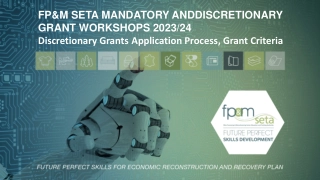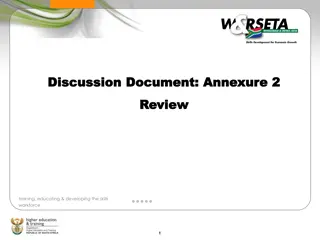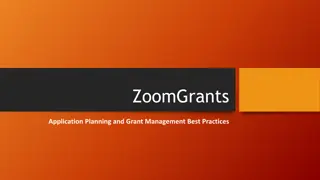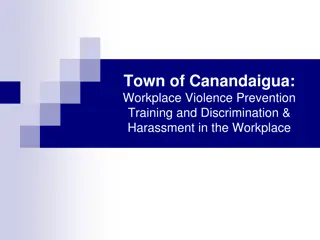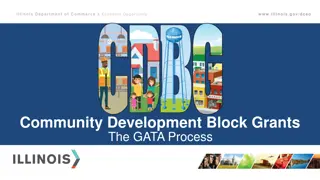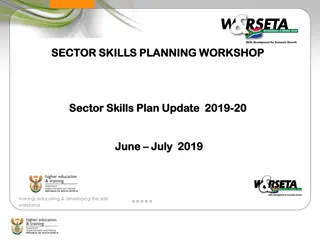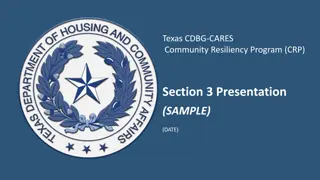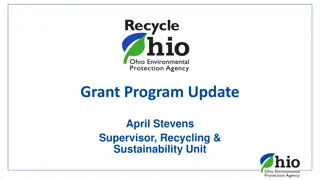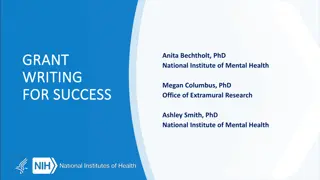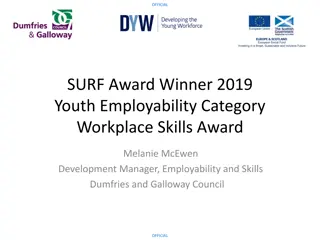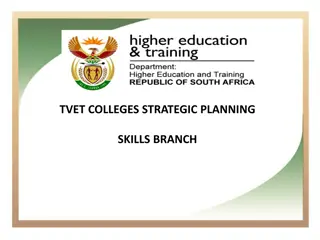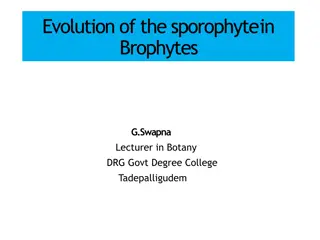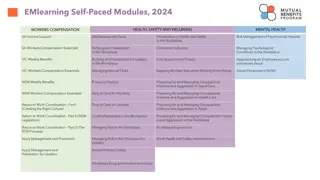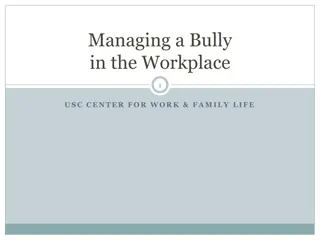Understanding SETA Grant Regulations and Workplace Skills Development
This presentation delves into the intricacies of SETA Grant Regulations governing the Skills Development National Skills Development Plan. It covers the legislative frameworks, submission trends, and the distribution of Skills Development Levy Income. The focus is on enhancing workplace skills development, promoting quality training programs, and encouraging employers to invest in training for their employees.
Download Presentation

Please find below an Image/Link to download the presentation.
The content on the website is provided AS IS for your information and personal use only. It may not be sold, licensed, or shared on other websites without obtaining consent from the author. Download presentation by click this link. If you encounter any issues during the download, it is possible that the publisher has removed the file from their server.
E N D
Presentation Transcript
FP&M SETA: MG and DG WORKSHOP 2022 Workplace Skills Plan & Annual Training Report Presentation 2022/23
Legislation Governing the Seta Skills Development National Skills Development Plan; Skills Development Act; Skills Development Levy Act; Seta Grant Regulations; Treasury regulations; Sector Skills Plan; Annual Performance Plan and Strategic Plan and White Paper, Green Paper etc. Economic Recovery and Reconstruction Plan (ERRP)
SETA Grant Regulations Regulate SETA administration fund; Provide for SETAs to contribute to QCTO; Discourage accumulation of surpluses; Improve quality and quantity of labour market information; Promote NQF registered and quality assured PIVOTAL programmes and Create framework for expanded use of public education and training providers.
WSP/ATR Submission 2011/12-2021/22 1600 1440 1413 1401 1396 1343 1323 1291 1278 1400 1258 1226 1200 1041 1000 800 600 400 200 0 2011-2012 2012-2013 2013-2014 2014-2015 2015-2016 2016-2017 2017-2018 2018-2019 2019-2020 2020-2021 2021-2022
Submission per Size 612 700 600 500 382 329 400 300 200 100 0 Large(150+) Medium(50-149) Small(1-49)
Submission per Sub-Sector 325 350 300 229 250 200 150 118 116 114 107 80 72 100 47 41 35 50 19 12 8 0
Submission per Province 500 436 450 400 352 340 350 300 250 200 150 100 70 65 31 50 13 10 6 0 Eastern Cape Freestate Gauteng KwaZulu-Natal Limpopo Mpumalanga North West Northern Cape Western Cape
Distribution of Skills Development Levy Income SARS 2 18 NSF Admin 49.5 10 QCTO 0.5 Mandatory Grant 20 Discretionary Grant
SETA Grant Regulations The intention of Mandatory Grants is to incentivize employers to: To plan & implement training for their employees; To create training and work experience opportunities for unemployed people Mandatory Grant Applications Submission due by 30 April 2022 Better alignment with skills development and financial year Enhanced SETA planning cycle SSP Annual Update Earlier Discretionary Funding Windows
Current Processes; who is eligible A levy paying employer claiming a mandatory grant must meet the eligibility criteria for the payment of a mandatory grant An eligible employer - has registered for skills development levies; has paid the levies in the prescribed manner (minimum threshold R500k per annum); has submitted a WSP / Sectoral Priority Occupation and InterventionsPlan and ATR/Sectoral Priority Occupation and InterventionsReport within the prescribed timeframes (30 April) that contributes to the relevant SETA SSP has submitted an Annual Training Report and/or Sectoral Priority Occupation and InterventionsTraining Report, demonstrating some alignment to the previous year s WSP and/or Sectoral Priority Occupation and InterventionsPlan
Workplace Skills Planning The Workplace Skills Plan (WSP), is one of the most powerful tools delivered to employers through skills development legislation. It is aimed at business expansion and sustainability; It is completed by companies with information specific to their business and the sector in which they operate; The Sector Skills Plan (compiled by the FP&M SETA) is an important resource to be used in the compilation of the WSP: Identify sector trends; Identify Priority Skills and Occupations in High Demand and Identify skills development interventions to address the Country s Labour Market and curb unemployment.
Workplace Skills Planning The construction of a WSP plays a major role in several vital areas Management and employees enter discussions regarding skills planning in the workplace; Skills available and skills gaps are identified and discussed in a positive way; Management has a platform to share the company s goals with employees, who in turn gain better understanding and more commitment to the process of achieving them and Companies begin to uncover talents and skills they did not know they had available.
Workplace Skills Planning The mandatory grant application consist of the following important sections: Organisational information Banking details Employment summary and Provincial Breakdown Provides information on the current workforce (including learners) Workplace Skills Plan Sectoral Priority Occupation and Interventionsplan Planned implementation of Sectoral Priority Occupation and Interventionslearning programmes e.g. apprenticeships, learnerships, credit bearing skills programmes, work-integrated- learning, bursary programmes (post-school / tertiary qualifications at TVETs/ HEIs) Non-Sectoral Priority Occupation and Interventions Plan Planned implementation of other learning programmes e.g. non-credit bearing skills programmes, in- house-training (health and safety, HIV/Aids awareness)
Workplace Skills Planning Annual Training Report Sectoral Priority Occupation and Interventions training report Actual implementation of Sectoral Priority Occupation and Interventions learning programmes e.g., apprenticeships, learnerships, credit bearing skills programmes, work-integrated- learning, bursary programmes (post-school / tertiary qualifications at TVETs/ HEIs) Non-Sectoral Priority Occupation and Interventionstraining report Actual implementation of other learning programmes e.g., non-credit bearing skills programmes, in-house training (health and safety, HIV/Aids awareness) Adult Education and Training Plan Training Committee (list of members) for medium and large firms only Sign-off (Authorisation page)
Workplace Skills Planning ATR and/or Sectoral Priority Occupation and Interventions Report must reflect all training conducted During April to March (of the previous financial year) Internally or Externally The WSP and/or Sectoral Priority Occupation and Interventions Plan must reflect all planned training Internally or Externally Planned for April to March (of the current financial year) Important to remember No Sectoral Priority Occupation and Interventions Plan/Report no discretionary grants for medium/large firms
SETA Grant Regulations Mandatory Grants Increased monitoring of WSP implementation against Board criteria Criteria for approval; Evidence requirements and Quality & accuracy standards for WSPs & ATRs. Evidence of consultation and sign-off by labour representative (unless explanation is provided).
Workplace Skills Planning The WSP/ATR must be duly authorised and signed-off by: The Internal Training Committee / Skills Development Committee including designated labour representative Firms employing 50 or more employees; or The Owner / Chief Executive and designated employee representative Firms employing less than 50 employees;
Workplace Skills Planning Deadline for submissions of the WSP and DG applications on/or before 30 April 2022: Applications to be submitted electronically via LMIS Scanned authorisation page and scanned current proof of banking details to be upload to MIS Original proof of banking details will be required from first time applicants or if an applicant s banking details have changed since the previous year s submission. Assistance will be supplied to applicants unable to access the LMIS on request Requests for extension: Anticipated delays by 31stMarch 2022 subject to approval by Board
Identifying Sectoral Priority Occupations and Interventions (SPOI) The fields of data that are completed include the following: OFO code framework version 19 and version 21 Occupation (Specialisation, Trade, etc.) Socio Economic Status Sectoral Priority Occupation and Interventions Programmes Sectoral Priority Occupation and Interventions Programme Name NQF Level Number of beneficiaries For OFO codes there is a search field and allows stakeholders to complete either the code of the occupation, or the name of the occupation. Both the OFO and the occupation name appear to ensure the code and occupation is perfectly matched. A drop down of the OFO codes and the name of the match to occupation appears in order to ensure alignment to the OFO code.
Identifying Sectoral Priority Occupation and InterventionsInterventions (SPOI) In the Sectoral Priority Occupation and Interventions section of the WSP/ATR, companies are requested to complete information on the type of Sectoral Priority Occupation and Interventions training they require. Clarity on what Sectoral Priority Occupation and Interventions means is emphasized during MG/DG workshops, focus groups and other stakeholder engagement sessions. The fields here include the type and appropriate/ preferred intervention for particular occupation, at a specific NQF level
SETA Sectoral Priority Occupation and Interventions and the SETAs Commitment Schedule The FP&M SETA s analysis of the WSP/ATR, and other data sources, to compile and OFO aligned Sectoral Priority Occupation and Interventions list. This list shows the priority skills areas that the FP&M SETA will be committing funding to in that financial period as recorded in the commitment register. This is achieved through constant alignment with the research done through the Sector Skills Plan and the SETA s reacting to it through its Strategic Plan and Annual Performance Plan.
The envisaged outcomes from the identified interventions Sectoral Priority Occupations and Intervention programmes that result in qualifications or part- qualifications registered on the National Qualifications Framework (NQF) that address OIHD. It is thus envisaged that through the selected interventions the FP&M SETA can: address the (Occupation in high demand) needs across all its 13 sub-sectors to ensure the constant creation of a growing skills pool for the necessary professional and technical needs of its sub-sectors to keep the companies within those sector competitive and productive. Address the urgent skills gaps Create pathways for new entrants through training programmes that lead to qualifications
FP&M SETAs Approach to the Sectoral Priority Occupation and Interventions List
The identified occupations that are Sectoral Priority Occupations and Interventions An important step in compiling the Sectoral Priority Occupation and Interventions is the vigorous analysis of the data received from all the 13 sub-sectors. Here the research team ensures that all the fields necessary for reporting are fully and correctly completed by the companies, it considers the logic used to ensure that the companies are applying the correct definition of terms involved. This is thus an intense process of working on the list and where necessary contacting the specific companies that may have made mistakes to work towards correcting these. The steps here include: Verification Correction Accuracy checks and Compilation of list
Criteria for Determining TOP 50 or 10 Sectoral Priority Occupation and Interventions List WSP/ATR Virtual focus group sessions one of the strategic objective targets e.g artisan development analysis In-depth interviews Literature review Interviews, Surveys and stakeholder phone calls Criteria to be met SCOPE of the FP&M sector skills needs
Occupational Shortages and Skills Gaps Sectoral Priority Occupation and Interventions What methods did the SETA employ in identifying occupations in the Sectoral Priority Occupation and Interventions? (a small summary of the methodology) Extent and nature of Supply What informed the interventions indicated in the SETA Sectoral Priority Occupation and Interventions? Occupational shortages and skills gaps What is the extent of occupational supply in the sector? What occupations are HARD-TO-FILL VACANCIES? (It takes longer than 12 months to fill the position) What are the envisaged outcomes from the identified interventions? What is the state of education and training provision? What consultative processes did the SETA use to arrive at the occupations identified in the Sectoral Priority Occupation and Interventions? What supply problems are firms experiencing? How many of these occupations are HTFVs? What are the main findings that informed the Sectoral Priority Occupation and Interventions? Why are these occupations hard-to-fill? Reasons (are they skills-related HTFVs or non-skills related HTFVs?) What informed the quantities indicated in the SETA Sectoral Priority Occupation and Interventions? Is the SETA Sectoral Priority Occupation and Interventions ranked, in order of priority? If so, what informed the ranking of occupations indicated in the SETA Sectoral Priority Occupation and Interventions? What are the major SKILLS GAPS in your sector at the major occupational level?
Implications for Sector Skills Plans WSP/ATR received by SETAs and analysed Occupation in high demand list compiled and a Sectoral Priority Occupation and Interventions produced SETA Sectoral Priority Occupation and Interventions LIST Labour market information analysed Alignment with SETA Strategic Plan & APP Demand for skills analysed Source: DHET
Sectoral Priority Occupation and Interventions Reporting Bursaries Apprenticeship Learning Programmes Learnerships Sectoral Priority Occupation and InterventionsLEARNING PROGRAMMES Skills Adult Education & Training Programmes Internships & Work experience Work Integrated Learning
Organising Framework for Occupations (OFO V19) OFO V21 received in December 2021 Purpose To standardise reporting terminology (easier to generate legislated reports) To report on skills demand and supply Inform the National Guide on occupations in high demand/ employment trends. The OFO is updated every two years Version 19 is used for Annual Training Report and Version 21 for the Workplace skills plans
Contact Details : GM Mr. PK Naicker Skills Planning Research and Reporting Manager Sylvia Tsunke 011 403 1700 Sylviat@fpmseta.org.za Skills Planning & Reporting Coordinator Sbahle Ndlovu 011-403 1700 SbahleN@fpmseta.org.za Skills Planning Specialist Xoliswa Radebe 011 403 1700 XoliswaR@fpmseta.org.za Johannesburg Pearl Ngiba 011-403 1700 PearlN@fpmseta.org.za REGIONAL OFFICES HEAD OFFICE Cape Town 021-462 0057 Durban Helvy Mnisi 031-7024482 HelvyM@fpmseta.org.za
Thank you 31


